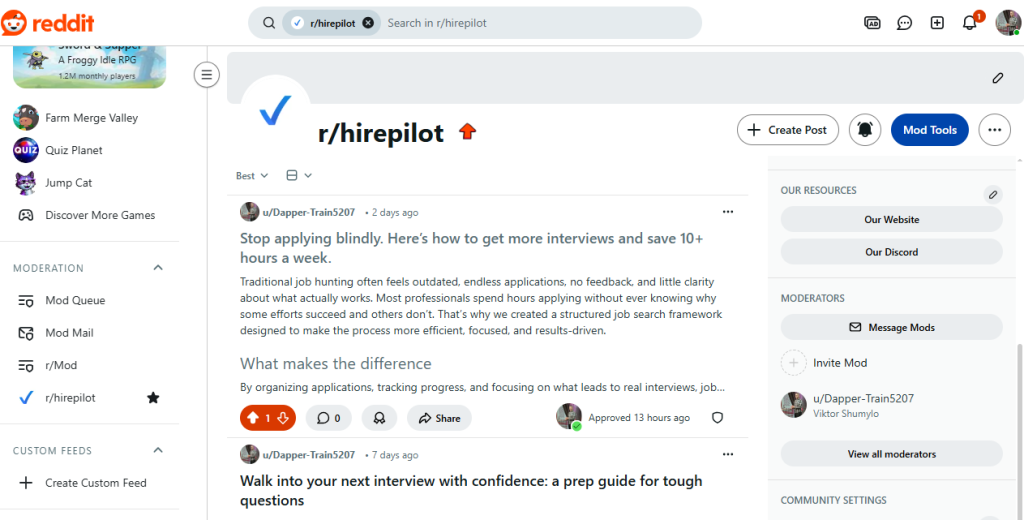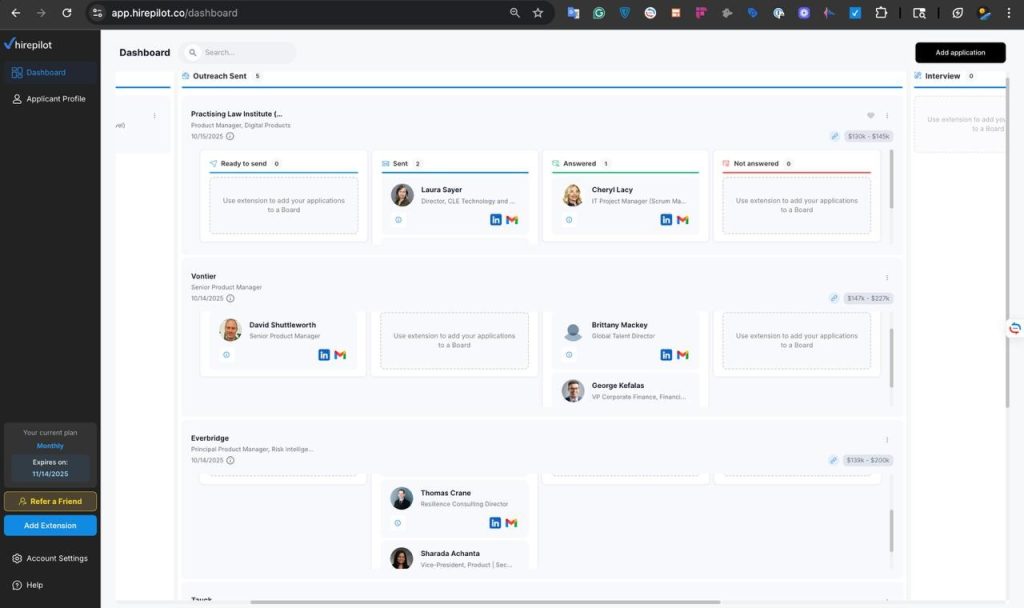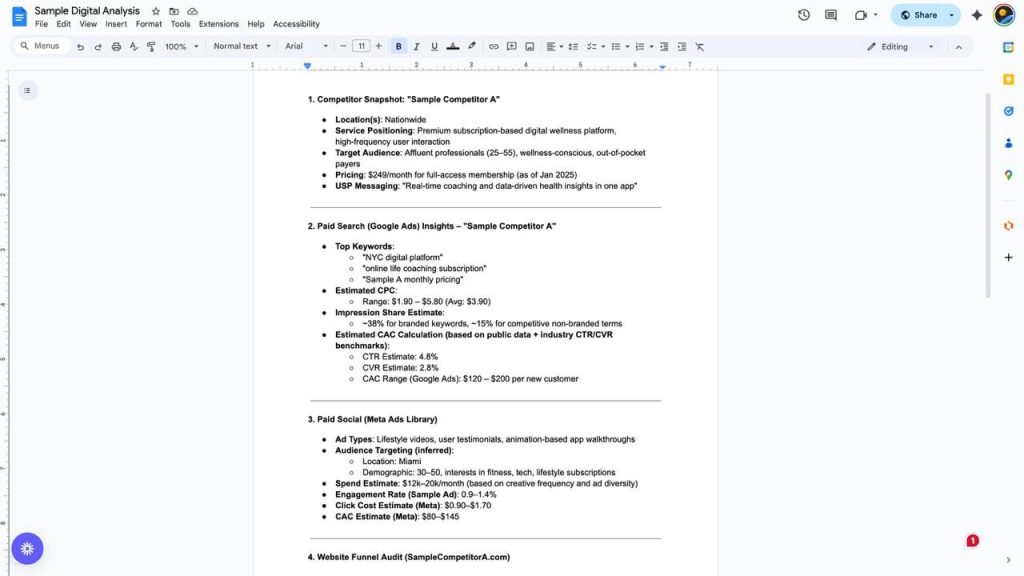Finding work today can feel like a full-time job itself. Endless forms, applicant-tracking systems, and ghosted applications make even qualified people doubt their skills.
But here’s the truth: the best ways to find a job in today’s market isn’t luck, it’s leverage. The people who land jobs faster use clear systems, AI tools, and modern outreach strategies that most seekers still ignore.
This guide breaks down ten proven, practical methods, each one tested by real candidates who stopped applying blindly and started getting results.
1. One of the best ways to find a job – stop applying everywhere, start applying intentionally
Most people still believe “the more applications, the better.” Yet volume kills focus.
Here’s how to fix it:
- Pick 10–15 target companies you’d genuinely love to work for.
- Open a simple Google Sheet or use your HirePilot Job Tracker.
| Company | Role | Contact | Date | Status | Next Step | - Set a Google Alert for “[Company Name] hiring.”
- Follow their LinkedIn page and turn on notifications for new posts.
- Schedule a follow-up five days after each application.
Tip: If you use HirePilot to track and auto-fill forms, you can cut application time by 70 %. See The Fastest Way to Apply for Jobs Online for details.
Why it works: focusing your energy on a shortlist lets you research each company, personalize your message, and look like a real match, not a mass applicant. This simple shift already puts you ahead of 90 % of job seekers searching for the best way to find a job.
2. Use LinkedIn as your job engine, not just a resume site

LinkedIn is still the most powerful place to find a job online because recruiters actually spend their days there. If you know how to search smartly, you can find roles before they’re public.
Try this workflow:
- In LinkedIn search, type: hiring “marketing specialist” or looking for remote designer → filter Posts.
- Save the search to refresh weekly.
- Engage with recent posts by liking and commenting.
- Message the poster with something human:
Hi [Name],
I saw your post about the [role].
I’ve worked on [short relevant result].
Would you mind if I send a quick summary of my work?
Avoid generic cover letters or attachments on first contact. Lead with value, then follow up in a week.
Bonus: Use AI tools like HirePilot or ChatGPT to personalize messages in seconds, see AI Networking: Your Guide to a Smarter Job Search.
How To Land Jobs That Aren’t Advertised
This method works because it turns LinkedIn from a static CV into an interactive network, the fastest path if you’re wondering how to get a job fast through real people, not algorithms.
3. Build a 3-message-per-day outreach routine
Outreach isn’t spam if it’s done with intention. Three messages a day can change your career faster than 300 applications.
Use the 3 W + 1 L formula:
- Who you are
- What you do
- Why you’re reaching out
- Low-pressure ask (“Mind if I share an idea?”)
Example DM that gets replies:
Hey [Name],
I saw what you’re building at [Company].
I’ve helped similar brands [achieve result].
Would you be open to a quick chat?
Keep it short (under 60 words). Focus on how you can help, not what you want.
Use AI Outreach Strategies (2025–2026) for tested templates and response timing.
Doing this daily trains you to see the job market as relationships, not forms. If you’re asking yourself how to find a good job, start by talking to the people who already work in one.
4. Use AI to personalize every application
AI isn’t just a buzzword, it’s your secret weapon to get hired faster without burnout.
Here’s how to automate without sounding robotic:
- Keep three versions of your resume (core, creative, technical).
- Paste the job description into ChatGPT or HirePilot prompt:
> “Match this resume to the [Job Title] role. Highlight relevant skills and rewrite summary for alignment.” - Generate a mini cover letter (100 words):
> “Write a short email-style cover letter for [role] at [company]. Tone: confident, human.” - Store optimized versions in a folder named “Applications 2025.”
Pro tip: Use the Automate Job Apply Guide to auto-fill forms and track progress 5× faster.
This is one of the simplest ways to learn how to find a job online that fits you, AI filters noise so you can focus on roles you actually want.
SHRM: LinkedIn and Your Job Search
5. Activate your hidden network
Most jobs aren’t advertised. They’re shared quietly between people who already know each other.
If you want to find a good job without sending 200 applications, start by re-activating your existing connections.
Here’s the exact process:
- Make a list of 30-50 people you’ve worked or studied with.
- Message 5 per week, friendly, not desperate.
Example:
Hey [Name], I’m exploring new roles in [field]. If you hear about any projects or openings, I’d love a quick heads-up. Hope you’re doing great! - Post on LinkedIn once:
> “I’m open to new opportunities in [field]. If your team is hiring or you know someone I should meet, I’d appreciate an intro.”
Add every positive response to your Warm Network tab inside the HirePilot Job Tracker. Talking to people, joining communities, and being visible online remain among the best ways to find a job that matches your goals.
Pro tip: Offer value first, share an article, comment on their project, or congratulate them. Reciprocity unlocks opportunities.
See Does Networking Really Get You 80% of Jobs?
This step alone often leads to “hidden” offers, especially if you’re wondering how to find a job you love, not just any job.
6. Join real communities, where jobs appear first

Job boards show you what’s open.
Communities show you what’s next.
The best way to find a job online is to be active in niche groups where opportunities appear long before they reach Indeed or LinkedIn.
Start here:
- Slack workspaces: Work In Tech, Remote OK Community, Design Jobs UK.
- Discord servers: Women in Marketing, Remote Designers.
- Reddit: r/hirepilot, r/jobs, r/marketing, r/remotework
When someone posts an opening, respond naturally:
“Thanks for sharing, just applied!” or “Appreciate this post, I specialize in [skill]. Would love to connect.”
Then record it in your tracker to monitor which communities give the best results.
Pro tip: Add a column “Source of Job” in your spreadsheet.
You’ll quickly see which networks actually work for you.
Explore AI Networking: Your Guide to a Smarter Job Search
7. Make your LinkedIn profile a magnet

LinkedIn can either be a static resume or your personal SEO engine.
Optimizing your profile is one of the simplest ways to get found by recruiters, especially if you want to find a good job that matches your skills.
Checklist:
- Banner: show your value in 7-8 words (“Turning chaos into clarity and strategy into growth”).
- Headline: skip “Looking for a job.” Write your expertise + impact.
- About: 3 short paragraphs → what you do, what results you deliver, what you seek.
- Featured Section: add links to your projects or posts.
- Activity: comment and post weekly so the algorithm keeps you visible.
Pro tip: Active profiles get shown in “People Also Viewed”, a free source of organic traffic.

See Best Job Search: Search for a Job on LinkedIn & More
How HR Professionals Can Create an Impressive LinkedIn Profile
When your profile clearly shows your impact and activity, recruiters start coming to you.
That’s how professionals quietly learn how to get a job fast, without ever clicking “Apply.”
8. Systemize and time your search (the weekly tracking formula)

Finding a job you love isn’t about luck, it’s about data and timing.
Candidates who treat their job search like a project get hired sooner.
Step-by-step:
- Use a tracking dashboard (HirePilot or Google Sheets).
Columns: Date | Company | Role | Contact | Status | Next Step | Result. - Apply on Tuesdays and Wednesdays (peak reply times).
- Follow up after 5 days using these Follow-Up Templates.
- Review weekly: what sources convert to interviews? Which don’t?
- Refine next week’s plan based on data, not emotion.
Explore Why Job Application Tracker Benefits Matter
Pro tip: Treat each week like a mini experiment.
If you notice more replies on Wednesday mornings, focus there, don’t spread your energy everywhere.
Systemizing your approach builds momentum and confidence. It’s the quiet secret behind people who look “lucky.”
9. The reverse hiring strategy: create your own opportunities
Most people wait for openings. But the best candidates create them.
This is one of the most underrated, yet most effective, ways to stand out and beyond.
Here’s how it works:
- Find fast-growing companies that haven’t posted jobs yet.
- Google: “recently raised funding” + [your industry]
- Check their “Team” or “News” page.
- Use LinkedIn’s “Company Insights” → Headcount Growth.
- Identify the gap.
Maybe they’re scaling marketing, or their site lacks technical SEO.
That’s your chance to show initiative.
Send a micro-proposal message:
Hey [Name],
Congrats on [Company]’s recent growth!
I noticed [specific gap or opportunity].
I’ve helped similar teams with [result].
Would you be open to a quick 10-min chat?
- It’s a soft pitch, value first, no begging.
Pro tip: Personalize it using Personalized AI Recruiter Outreach: Step-by-Step Guide. It’ll help you automate messages that still sound human.
Why it works: growing teams move fast. If you reach them right before they post a role, you’re the first name they remember and often the only one they need to interview.
That’s not just the best way to find a job, it’s how to get a job fast before anyone else even sees the posting.
10. The mini-project method (show, don’t tell)

Instead of saying “I’m good at what I do,” prove it.
Create a small, one-day project for the company you want to work for.
Example ideas:
- Marketer → design a quick ad concept or content idea.
- UX Designer → build a clickable prototype in Figma.
- Developer → fix one issue on their public repo or suggest optimization.
- Analyst → make a one-page data dashboard using their public data.
Then send a short message:
Hey [Name],
I love what [Company] is doing in [industry].
I made a quick project just for you – it’s a small idea that might help your team.
Here’s the link: [URL]
Thanks for inspiring me!
Pro tip: Upload it on Behance, GitHub, or your own portfolio and include visuals.
This “proof-first” move immediately positions you as proactive, not reactive.
How to Get More Interviews: Tactical Job Search Strategy
This is the ultimate power move if you want to find a good job and especially if you want to find a job you love. Companies notice people who take initiative. One thoughtful project can outperform 100 standard resumes.
Bonus: combine both: reverse + project
If you really want to stand out:
- Find a startup that just announced funding.
- Make a mini-project showing how you could improve their marketing or UX.
- Send your short pitch message with the project link.
You’ll look like part of their team before you’re even hired. There’s no single secret, the best ways to find a job combine structure, data, and relationships.
FAQ: Best way to find a job
1. What is the best way to find a job?
The best ways to find a job aren’t to apply everywhere, it’s to focus where you actually fit. Combine targeted search, AI-powered resume personalization, and smart outreach to hiring managers. Build a simple system to track every lead and conversation, so you always know where you stand. Most importantly, connect with real people, that’s where the majority of great jobs come from.
2. How to get a job fast?
If you want to get hired quickly, you need both speed and precision. Use AI tools like HirePilot to tailor resumes instantly and identify roles that match your strengths. Then, send short, personalized messages directly to recruiters or decision-makers instead of waiting in the resume pile. Fewer, better applications are always faster than hundreds of generic ones. See Automate Job Apply: Boost Applications 5×.
3. How to find a job online that fits me?
Finding a job online that truly fits you takes more than browsing major boards. Combine platforms like LinkedIn and Indeed with smaller, niche communities on Slack, Discord, or Reddit, that’s where many unlisted roles appear first. Set clear criteria (values, skills, remote or in-office preferences) and use trackers to compare offers. You’ll start recognizing which opportunities align with who you are. See Best Job Boards to Find High-Quality Jobs Online.
4. How to find a job you love, not just one that pays bills?
Start by defining what “a job you love” actually means for you, the environment, people, and daily work that make you feel alive. Then, do a short skills and values audit to see what kind of roles fit your natural strengths. Don’t rush, focus on alignment over speed, even if it takes a bit longer. The payoff is work that feels meaningful, check How Long Does It Take to Find a Job You Love?.
5. How to follow up after applying?
Following up after applying shows initiative, but timing matters. Wait about 5 business days, then send a short, polite message that reminds them who you are and adds value, a small idea or example of your work. This keeps you top of mind without sounding pushy. For real examples, use templates from How to Follow Up on a Job Application (With Templates That Actually Work).
Final thoughts
Finding a job in today’s AI-driven market can feel overwhelming, but it’s not impossible.
Once you systemize your search, personalize your outreach, and focus on fit instead of volume, the process becomes faster, smarter, and far more rewarding.
Stop applying blindly. Start applying intentionally.
Use AI, data, and real human connection and you’ll discover the best ways to find a job that truly fits you.
Tired of sending applications into a black hole?
Try HirePilot – your AI-powered job search co-pilot.
Track every opportunity, auto-fill applications, and finally see your progress from “Apply” to “Interview.”